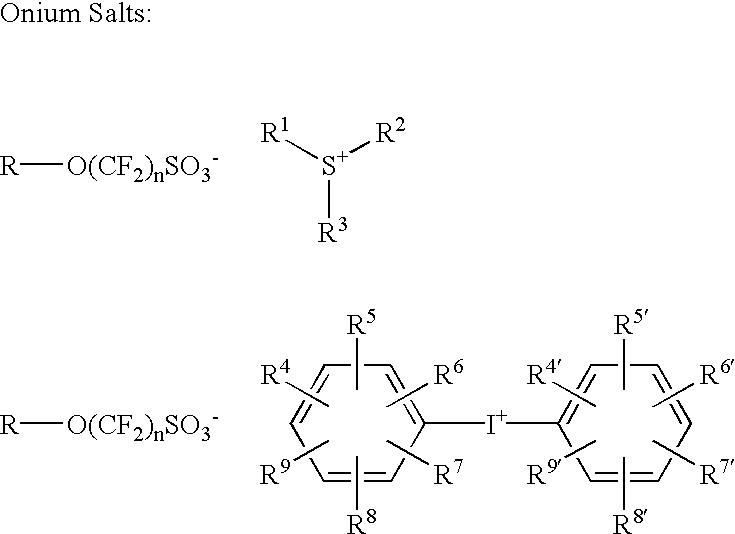Photoacid generators for use in photoresist compositions
a generator and photoresist technology, applied in the field of photoresists, can solve the problems of shorter perfluoroalkyl chain sulfonic acids, inability to address the combination of health and performance concerns, and inability to meet the long-term viability and availability of other, shorter chain perfluorinated sulfonic acid salts
- Summary
- Abstract
- Description
- Claims
- Application Information
AI Technical Summary
Problems solved by technology
Method used
Image
Examples
synthesis example 2
PAG SYNTHESIS EXAMPLE 2
Synthesis of 2,4,6-trimethylphenyldiphenylsulfonium mesylate
[0154] In a 1 L, round bottom flask equipped with a reflux condenser was combined 1,3,5-trimethylbenzene (40 g, 0.333 mol), diphenylsulfoxide (67.3 g, 0.333 mol) and Eaton's Reagent (160 g). An exothermic reaction occurred. The reaction mixture was maintained at 50-55.degree. C. with stirring for 5 hours. The reaction mixture was then added to deionized water (800 mL). This mixture was stirred for 30 minutes. The mixture was extracted two times with toluene (2.times.250 mL). The pH of the lower aqueous layer was adjusted to 8-8.5 by addition of a 25% aqueous solution of tetramethylammonium hydroxide (889.6 g).
synthesis example 3
PAG SYNTHESIS EXAMPLE 3
Synthesis of 4-(1-butoxyphenyl)diphenylsulfonium perfluoro(2-ethoxyethane)-sulfonate (PAG 1)
[0155] To a solution of 21 grams water and 6.5 grams (0.02 moles) perfluoro(2-ethoxyethane)sulfonic acid was added 2.5 grams of 33% aqueous solution of sodium hydroxide. 261 grams of a 4% aqueous solution of 4-(1-butoxyphenyl)diphenylsulfonium mesylate (from PAG Synthesis Example 1) was then added. Immediately a white suspension formed. 150 mL of chloroform was then added to this suspension. The resulting mixture was stirred for 16 hours. The lower chloroform solution layer was removed. The chloroform layer was washed six times with 75 mL portions of deionized water. The chloroform layer was then dried over magnesium sulfate. The magnesium sulfate was removed by filtration. Chloroform was removed from the filtrate on a rotary evaporator affording 13 grams of a viscous, yellow oil. 14
synthesis example 4
PAG SYNTHESIS EXAMPLE 4
Synthesis of tris(4-t-butylphenyl)sulfonium perfluoro(2-ethoxyethane)sulfo-nate
[0156] To a solution containing 2.04 g, 6.03 mmol PFEE-sodium salt in 54 grams water (prepared as in PAG Synthesis Example 3) was added 2.08 grams (4.02 mmol) of tris-(tert-butylphenyl)sulfonium tetrafluoroborate (Toyo Gosei) in 60 g of ethyl acetate. The resulting mixture was stirred for 24 hours. The bottom water layer was removed. The ethyl acetate layer (top) was washed four times with 30 ml portions of deionized water. The ethyl acetate layer was then dried over magnesium sulfate. The magnesium sulfate was removed by filtration. Ethyl acetate was removed from the filtrate on a rotary evaporator affording 2.5 grams of a white solid. The .sup.19F NMR spectrum contained the following resonance bands: .delta.-83.1(t, 2F), -87.7(s, 3F), -89.3(t, 2F), -118.9(s, 2F). The .sup.1H NMR contained: .delta.1.4(s, 27H), 7.8(AB quartet, 12H).
PUM
| Property | Measurement | Unit |
|---|---|---|
| Length | aaaaa | aaaaa |
| Surface energy | aaaaa | aaaaa |
| Depth | aaaaa | aaaaa |
Abstract
Description
Claims
Application Information
 Login to View More
Login to View More - R&D
- Intellectual Property
- Life Sciences
- Materials
- Tech Scout
- Unparalleled Data Quality
- Higher Quality Content
- 60% Fewer Hallucinations
Browse by: Latest US Patents, China's latest patents, Technical Efficacy Thesaurus, Application Domain, Technology Topic, Popular Technical Reports.
© 2025 PatSnap. All rights reserved.Legal|Privacy policy|Modern Slavery Act Transparency Statement|Sitemap|About US| Contact US: help@patsnap.com



